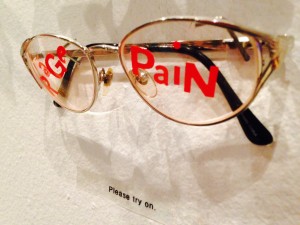
Rage & Pain: Please Try On / Glasses and Life Altered by PTSD. Photo Credit: Joe Atwood
Exhibit with Margaret Bellafiore
CURRENTLY SEEKING FUNDING AND APPLYING FOR GRANTS
We are expanding this installation in 2015. We’d love to bring the visuals as well as lectures and workshops to other trauma survivors, health activists and any who loves or works with trauma survivor or simply wants to better understand what toxic stress does to the body.
If you know of any grants or funding or venues – please contact [email protected]
9//17/2014: REVIEW OF Body Language Installation Suzi Looks at Art (click on the purple link)
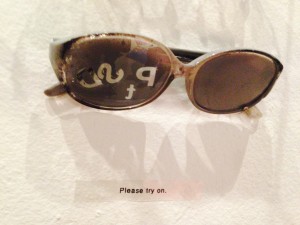
Please Try On PTSD: Life and glasses altered by symptoms: Photo Credit: Cissy White
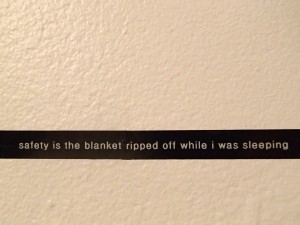
Trauma Survivor One Liners / Christine Cissy White
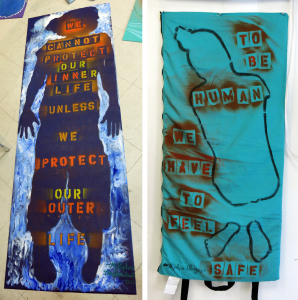
Altered Yoga Mats based on Work of Stephen Porges and Mary Pipher
Review from Julie Lovely, Executive Director of Wild Hearts Therapeutic Equestrian Program & Trauma Survivor.
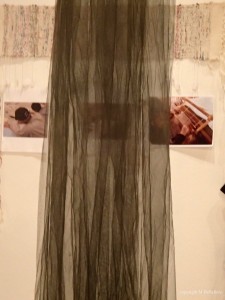
Gray Veil. Photo by Margaret Bellafiore
“Body Language: An Interactive Installation Exploring the Impact of Trauma: gives visitors the opportunity to experience the changes that occur in the body and brain as a result of surviving trauma. “Body Language” brings together trauma survivors, caregivers, and those who may have never had their lives touched by trauma. As a trauma survivor, I truly appreciate that “Body Language” allows everyone to experience the effects of trauma in both a visceral and tangible way. It helps to give us a common language and breaks down barriers between trauma survivors and those who have never experienced trauma, and even between trauma survivors themselves. It is when we truly understand each other that we can provide the best support
My husband has heard me describe my life after trauma as experiencing the world through a veil of gray. “Body Language” gave him the opportunity to look at the world through an actual gray veil and put on different pairs of eye glasses that fragment the world and make it difficult to see clearly. He could finally feel what I have described for so long – and it felt good to know that everyone who came through the exhibit could feel it too – I’m not alone.”
9/13/2014 & 9/14/2014: Photos from Show (Press Release below photos)
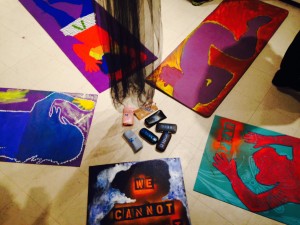
Altered yoga mats and “world covered in a gray of veil” veil. Photo by Joe Atwood.
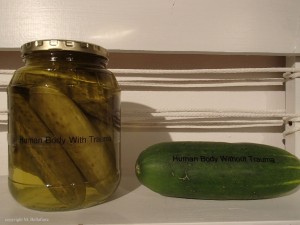
Trauma Pickles Pain: Photo by Margaret Bellafiore
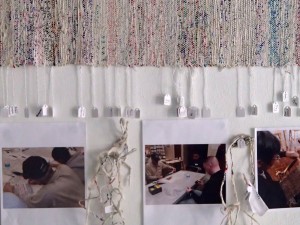
Spinning Pain into Art: Veterans write about trauma (Warrior Writers with civilians) and together weave experiences with help of http://spinayarnweavealife.com/2014/03/22/vets-speak-bridgewater-state-university/
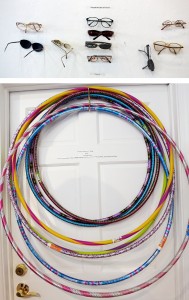
Understand the Ace with 10 hula hoops – you have to wear one for each answer you say yes to and observe how it feels to try to tie a shoe, get a sweater on and off and how the body has to adjust around the trauma and that the impact gets worse over time, not less.
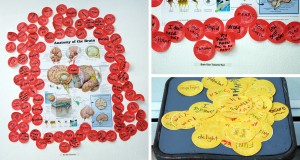
Brain Bias towards bad based on work of Rick Hanson. What sticks in the brain is the bad/negative and what gets lost and doesn’t create new paths is the “good” and so we have to work at making the “good” more sticky and helping the bad fall away.
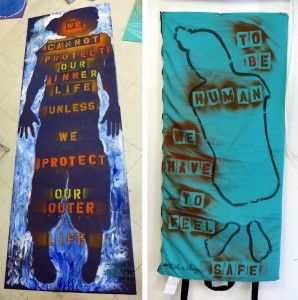
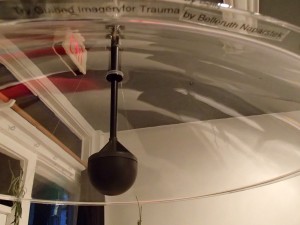
Audio Dome playing healing voice of Bellaruth Naparstek

Glasses & World Altered by PTSD. Photo by Joe Atwood.
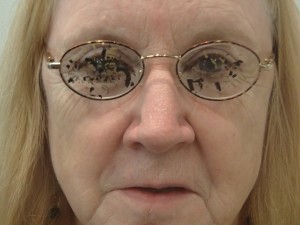
Glasses & Life Altered by PTSD symptoms: Photo by Margaret Bellafiore
8/5/2014: Press Release
“Trauma doesn’t happen as a story. It happens in the body, as sensations.”
Zahabiyah Khorakiwala, yoga teacher, counselor & survivor of rape
(Boston – August 5, 2014)
Body Language: An Interactive Installation Exploring the Impact of Trauma will be presented at Mobius, Saturday, September 13 at 7 PM and Sunday, September 14 at 2 PM at 55 Norfolk Street in Cambridge.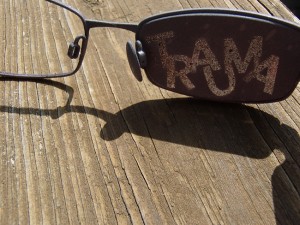
The exhibit is a result of the collaborative work of artist, writer and professor Margaret Bellafiore with activist, writer & trauma survivor, Christine Cissy White. Their piece is an inquiry into the way trauma and extreme stress are experienced.
Body Language draws on visual art, science, poetry and personal experience geared to an audience of both trauma survivors and non-trauma survivors. “It was as though the world were covered in a veil of gray” Julie Lovely said about the flatness she felt following trauma. At one station attendees will have the option of “trying on” that feeling by wearing eyeglasses with a gray veil. Bellafiore and White have designed several such stations using a variety of mixed media representations to show why and how trauma “stains” the brain and disrupts physiology.
Bellafiore and White’s understanding of trauma is influenced by information presented at the 2014 Trauma Conference in Boston on Psychological Trauma: Neuroscience, Attachment and Therapeutic Interventions as well as interviews with trauma survivors, poetic testimony, independent study and professional experiences related to the symptoms of traumatic stress.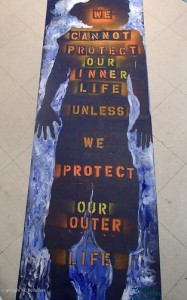

Margaret Bellafiore is a Mobius Artist Group member (www.mobius.org). She became interested in the subject of trauma when she interviewed returning veterans from Iraq and Afghanistan to college life for her sound installation at Mobius, Combat to Campus, the Voices of Veterans. In 2012 she wrote about this experience for the American Association of University Professors. (http://www.aaup.org/article/combat-campus#.U9_isvldWSp) Bellafiore recently worked on writing projects with student veterans at Bridgewater State University where she teaches art. She also wondered if there was a connection between the denial people have to interpersonal violence and the way society responds to climate change.
Christine Cissy White writes extensively about post-traumatic stress, trauma survivors and developmental trauma. She is published in the Boston Globe, Elephant Journal and Ms. Magazine online http://msmagazine.com/blog/2014/02/10/childhood-sex-abuse-silence-equals-shame/ and http://msmagazine.com/blog/2013/05/13/once-again-media-asks-wrong-questions-and-blames-victims/. Her articles, blog and website www.healwritenow.com blog have been shared online by Rick Hanson, co-author of Buddha’s Brain: The Practical Neuroscience of Happiness, Bellaruth Naparstek, author of Invisible Heroes: Trauma Survivors and How They Heal and the Rape And Incest National Network (RAINN).
“Trauma can have a multitude of consequences: It can produce abject misery, and make people abandon all hope; it can make the lust for revenge the center of people’s lives, at the expense of the ability to rebuild; or it can be sublimated into supreme acts of artistic transformation, and social action.”
Bessel van der Kolk
For more information, contact:
Margaret Bellafiore, 781 331 0711, [email protected]
Christine Cissy White, 781-331-4679, [email protected] www.healwritenow.com
[…] Body Language Trauma Exhibit […]